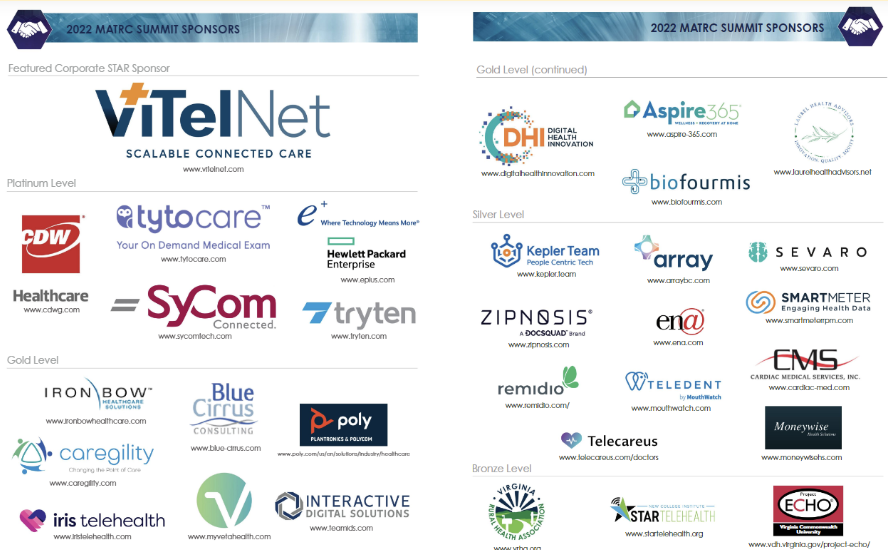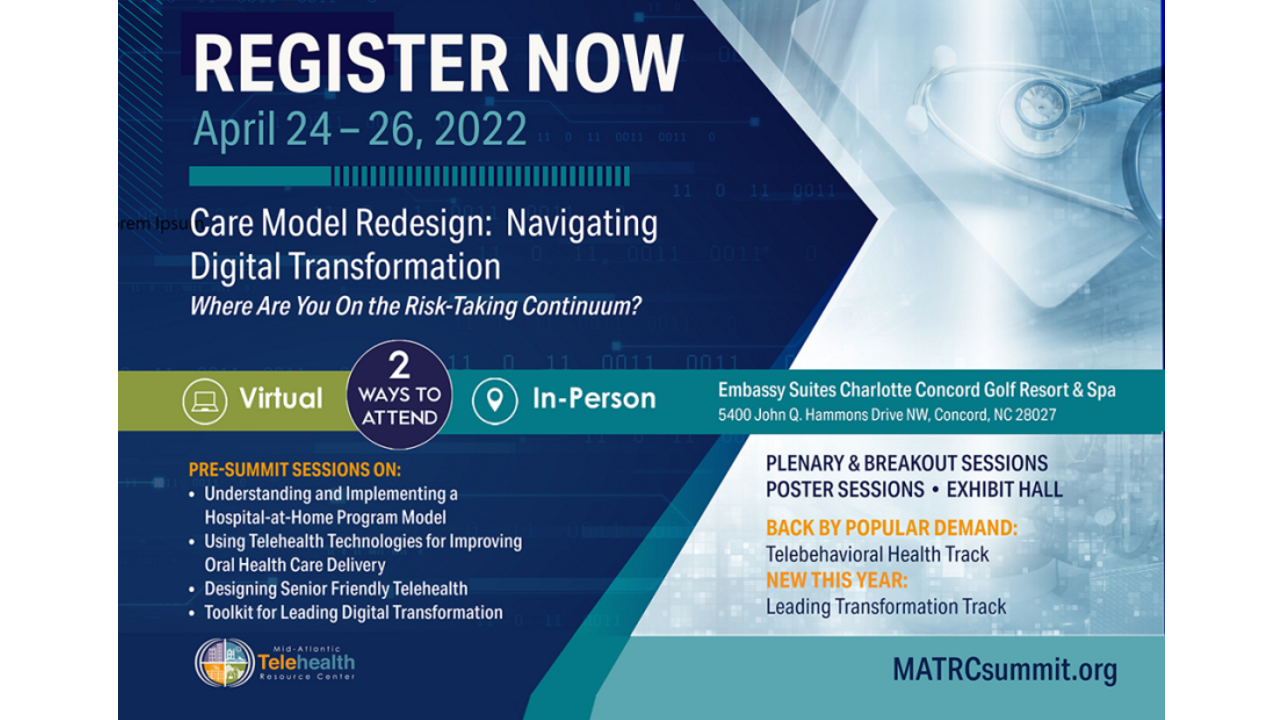I am writing these lines to you from the Mid-Atlantic Telehealth Resource Center (MATRC) Summit in Charlotte, NC.
Instead of my usual article I’d like to share this week some impressions and observations from the world of telehealth that I think you’ll find insightful and of interest. For further reading I have included a few links of relevant articles from the Telehealth Tuesday archive.
Hybrid Conferences and Hybrid Care
For those of you who do not know about MATRC, it is one of 12 regional telehealth resource centers that are funded by HRSA to provide telehealth support services. Since 2014, MATRC has been holding an annual “summit” with the last in-person conference in 2019, due to Covid. While the 2021 conference was virtual, this year’s conference was hybrid, or “Hybrid 1.0 Beta” as the executive director Kathy Wibberly described it.
The 2022 MATRC summit had about 250 in person and 250 virtual participants, with over a third of the speakers being remote as well — “presenting” the organizers with a real interesting logistical challenge that, at least from an in-person participant perspective, was managed extremely well.
For example, one of the sessions had an in-person and a virtual speaker and the transition back and forth, including the Q&A, was very smooth. For other sessions, virtual and in-person participants were able to participate in polls and submit Q&A questions online that the speakers could see and react to in real time.
Since I was also involved as a speaker and moderator of the “Leading Digital Transformation” track, I saw the enormous amount of planning, coordination and technology that it took to make the experience very smooth. Kudos to the whole team, demonstrating that hybrid can be done well!
As you can imagine, quite a few conversations revolved around comparing the complexity and parallels between a hybrid conference environment and a hybrid care environment (offering both in-person and virtual care). Over the past weeks, I actually had a number of people mention how disruptive or disorienting hybrid care is for some clinicians. I wrote about some remedies in my 2021 article about making hybrid care work. The most two critical aspects are to settle on the best scheduling approach (swiss cheese vs. block cheese) and to make sure that the critical workflows such as telerooming and the immediate follow up steps after the virtual visit.
Having been privy to what it takes to organize a hybrid conference (though the requirements are a bit different, because it is in person and virtual at the same time), the new expectation of hybrid in our post-Covid world definitely has its challenges (and growing pains).
Observations from the Exhibitor Floor
Interestingly enough, the exhibitor floor looked pretty much the same as in 2019. The usual suspects of telehealth solutions providers, telehealth service providers, telehealth organizations, and technology companies were present to demonstrate their offerings. Here’s a shout out to the companies that invested in advancing healthcare and supporting the conference:



What was different this year is how much many of the offerings have matured in terms of comprehensiveness and volume of clients. Just like in 2019, everyone was very bullish about the opportunities ahead, while still being apprehensive about what the future of telehealth after the expiration of the Public Health Emergency exceptions would hold. Though every vendor could clearly back up the value of telehealth that their clients were able to create.
Thus, barring any political showdown, there is really no reason why many of the barriers (such as Medicare’s 2001 rule about where telehealth could originate or the limitation on FQHCs and RHCs to offer telehealth to their patients) should not be lifted permanently. But like many things in healthcare policy it may take some years of back and forth until common sense will prevail….
Telehealth is growing up!
One thing that really struck me was the caliber of the participants and the speaker and how the topics were talking about some really mature concepts, many beyond the core subjects of telehealth summits in the past. I know that at least three dozen people in attendance have been involved in telehealth for more than 15, 20 or even 25 years, pretty much dedicating their career to have gotten this industry to where it is today.
The opening keynote grounded the attendees in reality and implored us to focus on our own and others’ happiness. Given the stressors and burnout of the past 2 years, this was an important topic to set the tone. The luncheon keynote, on the other hand, showcased specific examples of digital health and telehealth innovation that are showing demonstrable improvements, including digital health apps with FDA clearance and even reimbursement — clearly the next chapter in the journey from telehealth to connected health to digital health.
With three parallel tracks focusing on General Topics, Behavioral Health, and Leading Transformation, the first day offered a plethora and breadth of inspiring topics. Specific applications covered in posters and plenary sessions included: TeleGenetics, TeleMaternalHealth, TeleDentistry, TeleGeriatrics, TeleRetinopathyScreening, TelePharmacy, TeleSchoolCare, TeleNursingHomeTriage, TeleHomeCare, TelePsychiatry, TelePediatrics, TeleHomeless, etc. demonstrating how far telehealth has come.
The Behavioral Health track covered numerous topics from Care Practice Redesign in Behavioral Health to Telephonic Care and the TeleTreatment of Substance Use Disorders, whereas the Leading Transformation track (organized and moderated by Ingenium) brought inspiring insights from leaders leading transformation in healthcare organizations. A third big theme was also the changes occurring in the education of clinicians, counselors, and nurses, preparing the next generation for the digital health world.
The Future of Telehealth Conferences
A much formally and informally discussed topic was the future of telehealth conferences. At a price point of under $500 for 2 days of solid content, the MATRC conference, along with other regional conferences of other Telehealth Resource Centers, has definitely established itself as a valuable venue for professionals passionate about the future of digitally-enabled healthcare delivery of care. Other conferences, such as HLTH, VIVE, HIMSS or even the ATA, seem to have become elitarian and ridiculously expensive, seemingly catering to vendors with deep VC pockets and high-caliber medical institutions, leaving the hard-working grassroots innovators hanging.
At MATRC you can see first hand the hard work, the grunt work and talk to real people doing the real work.
Which is why I’ll be back again next year for sure!
If this recap piqued your interest, you can still sign up for the virtual option for quite a low amount and thus gain access to the recordings of the dozens of sessions.








To receive articles like these in your Inbox every week, you can subscribe to Christian’s Telehealth Tuesday Newsletter.
Christian Milaster and his team optimize Telehealth Services for health systems and physician practices. Christian is the Founder and President of Ingenium Digital Health Advisors where he and his expert consortium partner with healthcare leaders to enable the delivery of extraordinary care.
Contact Christian by phone or text at 657-464-3648, via email, or video chat.







Leave A Comment